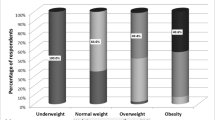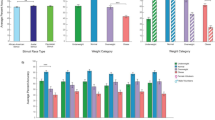Abstract
Objective:
To assess the size of biases in self-reported height, weight in a large sample of adolescents with special attention to possible effects of body dissatisfaction and to assess how such biases may influence estimates of overweight and obesity.
Design:
Cross-sectional study.
Setting:
Unselected population from Southwestern parts of Stockholm County, Sweden.
Subjects:
Two-thousand seven hundred and twenty-six boys and girls, 15 years of age.
Methods:
Data were collected by a questionnaire answered by adolescents and a physical examination made by trained study nurses. A validated physical appearance scale and body silhouettes were embedded into the questionnaire.
Results:
Obese boys under-reported their weight (5.2 kg) (95% confidence intervals (CI) 3.7; 6.6) more than obese girls (3.8 kg) (95% CI 1.8; 5.8). Agreement between self-reported and measured body mass index (BMI)-categories (obese, overweight and non-overweight/obese) as estimated by weighted kappa was 0.77 (95% CI 0.72; 0.82) for girls and 0.74 (95% CI 0.70; 0.79) for boys. For obese girls and boys sensitivity of self-reports were 0.65 (95% CI 0.47; 0.79) and 0.52 (95% CI 0.38; 0.66). Boys with low scores on the physical appearance scale under-reported their weight and BMI more than those with high scores. Boys and girls who wished to be leaner under-reported their weight and BMI more than subjects who were satisfied with their body size (P<0.05).
Conclusion:
Thirty-five percent of obese girls and 48% of obese boys would remain undetected from self-reported data. Boys and girls who were dissatisfied with their physical appearance or size under-reported their weight more than satisfied subjects.
This is a preview of subscription content, access via your institution
Access options
Subscribe to this journal
Receive 12 print issues and online access
$259.00 per year
only $21.58 per issue
Buy this article
- Purchase on Springer Link
- Instant access to full article PDF
Prices may be subject to local taxes which are calculated during checkout

Similar content being viewed by others
References
Altman DG (1997). Practical Statistics for Medical Research. Chapman & Hall: London, pp 406–407.
Brener ND, McManus T, Galuska DA, Lowry R, Wechsler H (2003). Reliability and validity of self-reported height and weight among high school students. J Adolesc Health 32, 281–287.
Bulik CM, Wade TD, Heath AC, Martin NG, Stunkard AJ, Eaves LJ (2001). Relating body mass index to figural stimuli: population-based normative data for Caucasians. Int J Obes Relat Metab Disord 25, 1517–1524.
Cole TJ, Bellizzi MC, Flegal KM, Dietz WH (2000). Establishing a standard definition for child overweight and obesity worldwide: international survey. BMJ 320, 1240–1243.
Crawley HF, Portides G (1995). Self-reported versus measured height, weight and body mass index amongst 16–17 year old British teenagers. Int J Obes Relat Metab Disord 19, 579–584.
Elgar FJ, Roberts C, Tudor-Smith C, Moore L (2005). Validity of self-reported height and weight and predictors of bias in adolescents. J Adolesc Health 37, 371–375.
Eriksson M, Rasmussen F, Nordquist T (2005). Changes in shape and location of BMI distributions of Swedish children. Acta Paediatr 94, 1558–1565.
Fortenberry JD (1992). Reliability of adolescents’ reports of height and weight. J Adolesc Health 13, 114–117.
Galan I, Gandarillas A, Febrel C, Meseguer C (2001). Validation of self-reported weight and height in an adolescent population]. Gac Sanit 15, 490–497.
Goodman E, Hinden BR, Khandelwal S (2000). Accuracy of teen and parental reports of obesity and body mass index. Pediatrics 106, 52–58.
Himes JH, Faricy A (2001). Validity and reliability of self-reported stature and weight of US adolescents. Am J Hum Biol 13, 255–260.
Himes JH, Hannan P, Wall M, Neumark-Sztainer D (2005). Factors associated with errors in self-reports of stature, weight, and body mass index in Minnesota adolescents. Ann Epidemiol 15, 272–278.
Himes JH, Story M (1992). Validity of self-reported weight and stature of American Indian youth. J Adolesc Health 13, 118–120.
Klesges LM, Baranowski T, Beech B, Cullen K, Murray DM, Rochon J et al. (2004). Social desirability bias in self-reported dietary, physical activity and weight concerns measures in 8- to 10-year-old African-American girls: results from the Girls Health Enrichment Multisite Studies (GEMS). Prev Med 38 (Suppl), S78–S87.
McCabe MP, Ricciardelli LA (2005). A prospective study of pressures from parents, peers, and the media on extreme weight change behaviors among adolescent boys and girls. Behav Res Ther 43, 653–668.
Rand CS, Resnick JL (2000). The ‘good enough’ body size as judged by people of varying age and weight. Obes Res 8, 309–316.
Spencer EA, Appleby PN, Davey GK, Key TJ (2002). Validity of self-reported height and weight in 4808 EPIC-Oxford participants. Public Health Nutr 5, 561–565.
Suonpaa E, Kresanov K, Ouvinen-Birgerstam P, Piha J (1989). Self-concept of Finnish children on the second grade of normal elementary school. Acta Paedopsychiatr 52, 157–164.
Villanueva EV (2001). The validity of self-reported weight in US adults: a population based cross-sectional study. BMC Public Health 1, 11 (http://www.biomedcentral.com/1471-2458).
Wang Z, Patterson CM, Hills AP (2002). A comparison of self-reported and measured height, weight and BMI in Australian adolescents. Aust NZ J Public Health 26, 473–478.
World Health Organisation (1998). Preventing and Managing the Global Epidemic Report of a WHO Consultation on obesity.
Author information
Authors and Affiliations
Corresponding author
Rights and permissions
About this article
Cite this article
Rasmussen, F., Eriksson, M. & Nordquist, T. Bias in height and weight reported by Swedish adolescents and relations to body dissatisfaction: the COMPASS study. Eur J Clin Nutr 61, 870–876 (2007). https://doi.org/10.1038/sj.ejcn.1602595
Received:
Revised:
Accepted:
Published:
Issue Date:
DOI: https://doi.org/10.1038/sj.ejcn.1602595
Keywords
This article is cited by
-
Misreporting of height and weight by primary school children in Japan: a cross-sectional study on individual and environmental determinants
BMC Public Health (2023)
-
Relationship Between Subjective Wellbeing and Weight Perception in Children and Adolescents: Gender and Age Differences
Child Indicators Research (2017)
-
Applying a correction procedure to the prevalence estimates of overweight and obesity in the German part of the HBSC study
BMC Research Notes (2014)
-
Self-reporting and measurement of body mass index in adolescents: refusals and validity, and the possible role of socioeconomic and health-related factors
BMC Public Health (2013)
-
Validity and predictors of BMI derived from self-reported height and weight among 11- to 17-year-old German adolescents from the KiGGS study
BMC Research Notes (2011)



